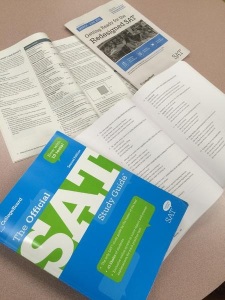
By Bailey Schwab, Features Editor
The College Board SAT test will be undergoing some drastic changes this spring, including a new 1600 point scale, an optional essay, a non-calculator section, and the elimination of a penalty for wrong answers.
The new SAT will include an 800 point section on math and another 800 point section covering reading/writing. Reading and writing will now be combined instead of having three sections, totaling a possible 2400 points. Different from the previous test, the essay is now optional because writing skills are combined with reading in the multiple choice section.
Lisa Kump, a teacher of the SAT prep course offered at River Hill, explains “The most drastic changes are the format of the test. The sections are longer in duration and more questions to answer, like the ACT.”
Multiple choice sections will now have four options instead of five, and there is no penalty for a wrong answer. On the previous test, there was a ¼ point deduction for incorrect answers.
The essay part of the test gives students a 50 minute time period to draft a response rather than only 25 minutes. Students will be asked to analyze a 650-750 word passage and respond to the prompt using evidence from the text. The score of the essay will be separated from the other multiple choice sections and not combined in the 1600 point total.
In order to better prepare for the test, Kump’s prep course “will just be focusing on the New SAT (March 2016). We will prepare for the test through an examination of new reading selections, mostly nonfiction, historical documents, and graphs.”
The math portion of the test will consist of a calculator section and a non-calculator section, 55 minutes with a calculator and 25 without. The math portion will be split up into two subsections, “The Heart of Algebra” and “Passport to Advanced Math.”
A calculator will be permitted for 37 questions, and 20 questions must be answered without the calculator. The previous SAT test allowed calculators to be used for all problems. Questions will also focus on analyzing graphs and include more real world application.
The reading and writing section will make content changes by removing sentence completions. Passages will most likely be informational text, relating to sciences, history, literature, and/or careers. Students are allotted 3 hours to complete the test and an extra 50 minutes if they wish to complete the essay.
Kump claims, “I absolutely recommend the our students complete the essay. Our writing program at RHHS is very strong and our students are well prepared for reading an article and evaluating the rhetoric and argument of authors.”
Other test changes include a decrease in emphasis on vocabulary. Kump confirms that “the vocabulary commitment is very small compared to the old test. The old test student needed to know 1100 words. Now the new test requires only knowledge of words in context.”
The content changes in the new test should more directly relate to high school curriculum than the previous test. College Board test makers claim they felt the SAT was surrounded by unnecessary and costly test preparation rather than knowledge learned in school.
Kump also wishes to remind students “the name of the game is select a school that fits the kind of student you are and allows you to become a stellar individual in this world!”

